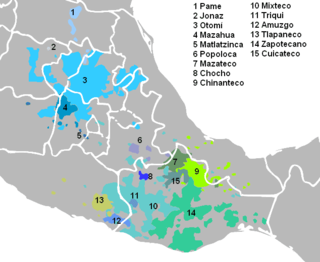
Back لغة أوتومي Arabic Idioma otomí AST Otomeg Breton Otomí Catalan Otomí-Sprache German Idioma otomí Spanish Otomiera Basque Langues otomies French Lingua otomí Galician Lingua otomí Italian
| Otomi | |
|---|---|
| Region | Mexico: México (state), Puebla, Veracruz, Hidalgo, Guanajuato, Querétaro, Tlaxcala, Michoacán |
| Ethnicity | Otomi |
Native speakers | 300,000 (2020 census)[1] |
Oto-Manguean
| |
| Official status | |
Official language in | In Mexico through the General Law of Linguistic Rights of Indigenous Peoples (in Spanish). |
| Regulated by | Instituto Nacional de Lenguas Indígenas [1] |
| Language codes | |
| ISO 639-2 | oto |
| ISO 639-3 | Variously:ote – Mezquital Otomiotl – Tilapa Otomiotm – Highland Otomiotn – Tenango Otomiotq – Querétaro Otomiots – Estado de México Otomiott – Temoaya Otomiotx – Texcatepec Otomiotz – Ixtenco Otomi |
| Glottolog | otom1300 Otomisout3168 Southwestern Otomi |
 Otomi-speaking areas in Mexico | |
 The Otomi languages within Oto-Manguean, number 3 (bright blue), north | |



Otomi (/ˌoʊtəˈmiː/ OH-tə-MEE; Spanish: Otomí [otoˈmi]) is an Oto-Pamean language spoken by approximately 240,000 indigenous Otomi people in the central altiplano region of Mexico.[2] Otomi consists of several closely related languages, many of which are not mutually intelligible. The word Hñähñu [hɲɑ̃hɲṹ] has been proposed as an endonym, but since it represents the usage of a single dialect, it has not gained wide currency. Linguists have classified the modern dialects into three dialect areas: the Northwestern dialects are spoken in Querétaro, Hidalgo and Guanajuato; the Southwestern dialects are spoken in the State of Mexico; and the Eastern dialects are spoken in the highlands of Veracruz, Puebla, and eastern Hidalgo and villages in Tlaxcala and Mexico states.
Like all other Oto-Manguean languages, Otomi is a tonal language, and most varieties distinguish three tones. Nouns are marked only for possessor; the plural number is marked with a definite article and a verbal suffix, and some dialects keep dual number marking. There is no case marking. Verb morphology is either fusional or agglutinating depending on the analysis.[cn 1] In verb inflection, infixation, consonant mutation, and apocope are prominent processes. The number of irregular verbs is large. A class of morphemes cross-references the grammatical subject in a sentence. These morphemes can be analysed as either proclitics or prefixes and mark tense, aspect and mood. Verbs are inflected for either direct object or dative object (but not for both simultaneously) by suffixes. Grammar also distinguishes between inclusive 'we' and exclusive 'we'.
After the Spanish conquest, Otomi became a written language when friars taught the Otomi to write the language using the Latin script; colonial period's written language is often called Classical Otomi. Several codices and grammars were composed in Classical Otomi. A negative stereotype of the Otomi promoted by the Nahuas and perpetuated by the Spanish resulted in a loss of status for the Otomi, who began to abandon their language in favor of Spanish. The attitude of the larger world toward the Otomi language started to change in 2003 when Otomi was granted recognition as a national language under Mexican law together with 61 other indigenous languages.
- ^ Lenguas indígenas y hablantes de 3 años y más, 2020 INEGI. Censo de Población y Vivienda 2020.
- ^ INEGI (2009:69)
Cite error: There are <ref group=cn> tags on this page, but the references will not show without a {{reflist|group=cn}} template (see the help page).